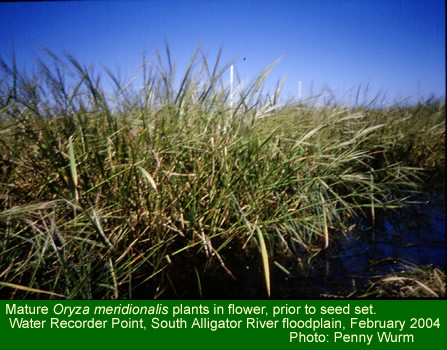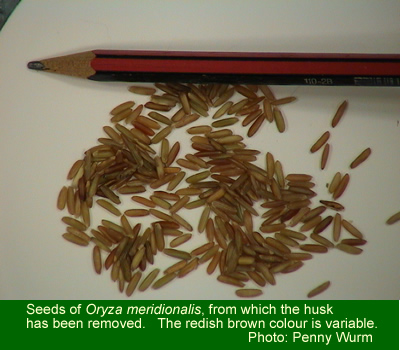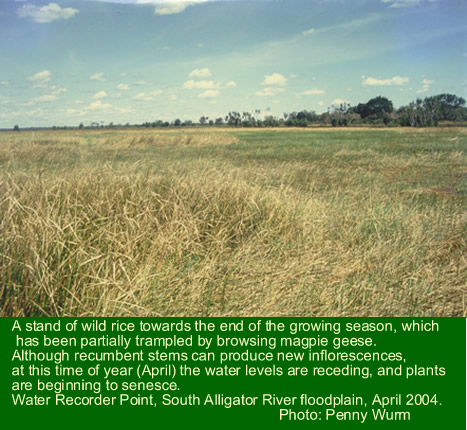


Summary of final report on the Australian Flora Foundation funded project:
Wurm, P.A.S., School of Science & Primary Industry
Charles Darwin University
Wild rice Oryza meridionalis Ng (formerly Oryza rufiopogon Griff.) is a widespread and abundant annual floodplain grass, endemic to northern Australia. Its seeds provide an important annual food resource for floodplain fauna, particularly the Dusky Plains Rat Rattus colletti and the Magpie Goose Anseranas semipalmata.
Floodplains of the monsoonal wet-dry tropics are a hydrologically dynamic habitat. During the annual wet season, the underlying clay soils are flooded by 10 to 200 cm of water, while during the dry season they are dry and deeply cracked. The annual wetting and drying cycle is a reliable occurrence, but the timing of wet season onset, and the extent and duration of inundation are not.
This study investigated the significance of inundation regime to growth and fecundity of O. meridionalis in a tank experiment, growing potted plants in four inundation treatments.
The growth habit, vegetative productivity, fecundity and mortality of O. meridionalis plants were significantly affected by inundation regime, with plants grown in the two intermediate inundation regimes (with maximum depths of 15 and 74 cm) being the most vegetatively productive. The two intermediate inundation treatments also resulted in the greatest number of spikelets per plant (a mean range of 1,900 and 2,300 spikelets per plant). Both the exposed and deepest treatments (0 cm and 120 cm respectively) resulted in significantly fewer spikelets per plant.
Although inundation regime had a significant effect on growth and fecundity, reproductive output was still over 700 spikelets per plant in all treatments, illustrating the plasticity of growth of O. meridionalis in response to inundation. The 700 spikelets per plant in this study equates with 30,100 spikelets m-2 in the field.
The preference of O. meridionalis in the field for areas of intermediate depth is unlikely to be explained only by inundation alone. Although spikelet production for O. meridionalis, was significantly decreased by the driest and wettest inundation treatments, it was still high (>700) under a 120 cm range of inundation regimes. In the field inter-specific competition and density-dependent effects, may also interact with these edaphic factors to limit spikelet production and O. meridionalis population size. Ability to tolerate abiotic “stress” is frequently inversely related to competitive ability, and this high reproductive effort under a range of inundation regimes may at the expense of the competitive ability of O. meridionalis. However if habitat variability, such as inundation regime, limits the growth and reproduction of perennial species, then O. meridionalis would be well placed to occupy any vacated space.
In the field, significant differences in growth and fecundity were also detected between years of different inundation period. For example, the 1992 wet season commenced 6 weeks later than it did in 1994. This additional time for vegetative accumulation prior to the initiation of inflorescences also may have contributed to higher spikelet production in the field populations.

